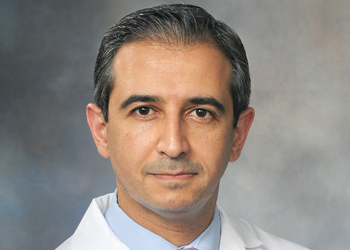Endoscopy: How does it work and what are the benefits?

Have an endoscopy scheduled or just curious about the procedure? Dr. Hashem El-Serag, chief of gastroenterology and hepatology at Baylor College of Medicine, says patients shouldn’t fear having the procedure.
He dispels myths and explains the importance of having an endoscopy and screening for Barrett’s esophagus and esophageal cancer in the Q&A below.
Q: What is an endoscopy?
An endoscopic examination includes inserting a tube into the patient’s esophagus to examine it closely and to take a biopsy of pieces of tissue. Typically an endoscopy is performed after the patient is sedated.
Q: Who should get an endoscopy?
There is no clear guideline for a specific age to have the first screening endoscopy to find out whether or not a patient may have Barrett’s esophagus or cancerous precursor lesions, although many experts recommend ages 40 to 50.
Patients with persistent heartburn who do not experience relief with medication also should consider having an endoscopy. Chronic acid reflux causes Barrett’s esophagus and also is the leading risk factor for esophageal cancer. An endoscopy will help their doctor monitor any possible cancer growth so it can be removed early to increase their chances of living longer, healthy lives.
Q: Why is it important that patients have an endoscopy?
An endoscopy is the best method to detect Barrett’s esophagus and early esophageal cancer. I can tell if a patient has Barrett’s when the lining of the esophagus, typically white, is changed to a shade of red, and I would then obtain a sample to examine under the microscope.
Patients who have Barrett’s esophagus are at a greater risk for developing ulcers, narrowing and cancer of the esophagus. They also have increased risk of developing a specific type of cancer: esophageal adenocarcinoma, which is affecting more and more people every year. It is the fastest rising cancer in Caucasian men in the United States.
Treatment for Barrett’s esophagus and early esophageal cancer can be achieved through endoscopy thus saving the esophagus from major surgery.
Unfortunately, in most patients the cancer is discovered at a late stage, which is why it is important to have an endoscopy to screen for the precursor lesions and have a biopsy of sample tissue.
Q: How long does an endoscopy take?
The average time to perform an endoscopy is five minutes. Endoscopy is safe and the risk of major complication is low. It’s actually 1 in 10,000 procedures. Patients may experience a sore throat and bloating, which resolves a few hours after the procedure.
Q: How often should patients have an endoscopy?
It is strongly recommended that a gastroenterologist examines patients already diagnosed with Barrett’s esophagus every three to five years.
The pathologist will look at sections of the tissue biopsy to determine if there is cancer. By examining the tissue, the pathologist also will be able to determine if there are any abnormal changes or dysplasia (pre-cancer) on the esophageal tissue samples.
If dysplasia is detected, treatment with endoscopic radiofrequency ablation offers a great opportunity to completely cure the patient while preserving the esophagus.
Q: Are there alternatives to an endoscopy that can screen for Barrett’s esophagus and esophageal cancer?
Alternatives to endoscopy are an active area of research. Specialized brushes and blood tests are being pursued but nothing has proven more effective than an endoscopy.
Questions about esophagus health? Schedule an appointment with our experts at 713-798-0950.



